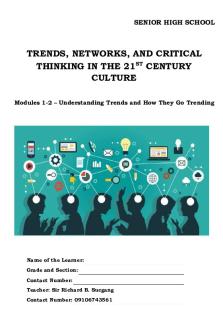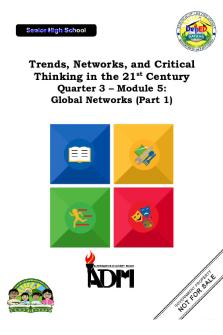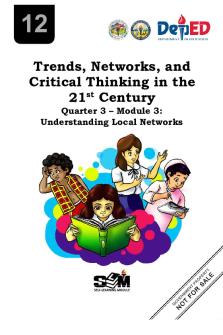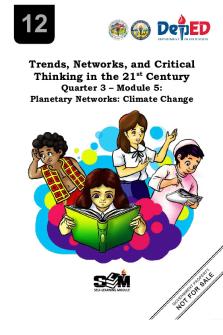TNCT Module 3-4 - TRENDS, NETWORKS, AND CRITICAL THINKING PDF

| Title | TNCT Module 3-4 - TRENDS, NETWORKS, AND CRITICAL THINKING |
|---|---|
| Course | Bachelor of Secondary Education |
| Institution | Mindanao State University |
| Pages | 16 |
| File Size | 466.7 KB |
| File Type | |
| Total Downloads | 682 |
| Total Views | 843 |
Summary
SENIOR HIGH SCHOOLTRENDS, NETWORKS, AND CRITICALTHINKING IN THE 21ST CENTURYCULTUREModules 3 – Identifying Parts of a Whole and Emerging Patternsin TrendsModule 4 – Understanding Strategic Analysis and IntuitiveThinkingName of the Learner: Grade and Section: Contact Number: Teacher: Sir Richard B. S...
Description
SENIOR HIGH SCHOOL
TRENDS, NETWORKS, AND CRITICAL THINKING IN THE 21ST CENTURY CULTURE Modules 3 – Identifying Parts of a Whole and Emerging Patterns in Trends Module 4 – Understanding Strategic Analysis and Intuitive Thinking
Name of the Learner: Grade and Section: Contact Number: Teacher: Sir Richard B. Sucgang Contact Number: 09106743561
CONTENT STANDARDS The learner understands the emergence of trends and patterns. PERFORMANCE STANDARDS The learner will be able to derive an idea from instances and present this idea through a 100-word essay, artwork, and other graphic representations. KEEP IN MIND To learn and benefit from this module, follow the following steps: 1. Read the module title and the module introduction to get an idea of what the module covers. Specifically, read the first two sections of this module carefully. The first section tells you what this module is all about while the second section tells you of what you are expected to learn. 2. Never move on to the next page unless you have done what you are expected to do in the previous page. Before you start each lesson, read first the INSTRUCTIONS. 3. Work on the activities. Take note of the skills that each activity is helping you to develop. 4. Take the Post-Test after you are done with all the lessons and activities in the module. 5. Meet with your teacher. Ask him/her about any difficulty or confusion you have encountered in this module. 6. Finally, prepare and gather all your outputs and submit them to your teacher. 7. Please write all your answers of the tests, activities, exercises, and others IN YOUR MODULE. Use a separate paper IF NECESSARY.
LEARNING COMPETENCIES The learners will be able to: 1. Identify parts of a whole (HUMSS_MCT12-Ia-b-6); 2. Identify and explain an emerging pattern (HUMSS_MCT12-Ia-b-7); 3. Identify causes and consequences (HUMSS_MCT12-Ia-b-8); 4. Explain strategic analysis and intuitive thinking (HUMSS_MCT12-Ic-e- 2); a. Define strategic analysis and intuitive thinking (HUMSS_MCT12-Ic-e 1); b. Differentiate key components in strategic analysis and intuitive thinking (HUMSS_MCT12-Ic-e-5); 5. Apply strategic analysis (HUMSS_MCT12-Ic-e-3); and 6. Apply intuitive thinking in solving a problem in the community using a map of social networks (HUMSS_MCT12-Ic-e-4) (HUMSS_MCT12-Ice- 6).
1
PRETEST Directions: The following are statements about TREND. Write TRUE if the sentence is correct, write FALSE otherwise. Write your answers on the space before the number. 1. Trends are formed from the combination of things. 2. Music videos, image-sharing mobile apps, and emojis are some of the more physical manifestations of people captivated by the visual culture. 3. A larger thing (the whole) does not consist of smaller things or parts. 4. Megatrend demographics.
includes
urbanization,
automation
and
changing
5. Microtrend shows the tendency in the direction of some phenomenon that is fairly pervasive within a given sphere of influence and lasts for only a few years and is common to business management. 6. Macrotrends can endure for surprisingly a long time and affect most of the society. 7. Notebook and pen are basic in documentation. 8. Interviews and friendly-group discussions (FGD) are ways to catch emerging patterns. 9. Identifying emerging patterns can be used to introduce individuals, organizations and communities change, improvement, transformation, and new opportunities. 10. Documentation is the stage where examination and combination happen. 11. The important thing in documentation is the ability to physically keep information and data wherever and whenever you may be. 12. New trends are labeled with new names or terms in the hope of popularizing a phenomenon. 13. The tools that a trend spotter should find handy to use are categorized into four activities such as documentation, archive or memory, analysis and representation. 14. Tagging and cross-indexing are helpful in labeling files. 15. Once patterns are identified, trends are given irrational explanations for their emergence or existence and are provided with a better understanding of their cultural origins.
2
DISCUSSION LESSON 1: IDENTIFYING PARTS OF A WHOLE AND EMERGING PATTERNS IN TRENDS Identifying Parts of a Whole Trends as they grow and evolve tend to influence or give birth to other trends and become interconnected and interrelated. It was mentioned in the previous modules that trends are formed from the combination of things. Thus, a trend has constituent parts of portions that are interrelated. Their influence, as well as how the people adopt them, makes the trend viable, especially the megatrends and gigatrends. Take as example the Japanese animation (animé) trend that is associated with several generations spanning decades. In retrospect, Urgel (2017) illustrated the popularity of anime which was brought about by a number of developments such as the ones shown below.
Visual culture is another example that we experience today. It was developed from various trends─ digital camera, smartphone, internet, Wi-Fi technology, social media, mobile apps, computer, fashion, art, photography, to name a few. Internet memes, infographics, and sharable videos seemed to be a microtrend only, but they eventually became a mainstay in disseminating information. Even large news organizations and government websites use them.
3
This visual culture trend which can be considered a megatrend, has evolved further with the advent of the internet. The smartphone and Wi-Fi access greatly helped the new form of visual culture which is subscribed to by many social media users, if not all. Remember that microtrends can become macrotrends if they affect more lives and societies. Then, macrotrends can become a megatrend if it can affect a much larger group for a longer period like a decade. Megatrends can become gigatrends if they have everlasting effects and influences. Therefore, it is evident that the whole which comprises the large part is made up of small things or parts. This can be visualized below:
Identifying Emerging Patterns By simply looking at the previous diagram, you will somehow have an idea on identifying emerging patterns of a trend. Urgel (2017) defined pattern as a design, shape, form or configuration that emerges from repetitious appearance
4
of lines, curves, and behavior. According to him, in the study of trends, repetitive behavior that gives rise to an emerging pattern is the main interest. In order to follow and observe if a pattern emerges out of various events and phenomena, one should have the tools necessary to detect it. According to Rehn and Lindkvist (2013), the tools that a trend spotter should find handy to use are categorized into four activities which are as follows: 1. Documentation means being able to record your observations which you consider related to any trend. The primary tools for documentation, however simple, are notebook and pen. Some opt to use note-taking features or apps on a smartphone or tablet. The camera has also become necessary in providing visuals. Others bring a voice recorder which is best for saving audio. Whatever tool one uses, the important thing in documentation is the ability to physically keep information and data wherever and whenever you may be. Notebook and pen are basic in documentation. 2. Archive or Memory is used to easily retrieve any documentation you have kept. Notes can be scanned or converted to a portable document format (PDF) while digital pictures can be easily saved. Physical archiving can, of course, still be used. There are various digital archiving systems that are available, too. Tagging and cross indexing are helpful in labeling files. 3. Analysis is the stage where examination and combination happen. Looking for patterns on prospective trends can be achieved through these methods: brainstorming, grouping, and crafting combinations. In brainstorming, you decide which from your data is important and which can be discarded. Here, you can confirm emerging patterns like events becoming more frequent and things following a cycle. In grouping, you create headings where observations and data can fall under several categories. In crafting combinations, you begin to link one thing to another and think what could happen if these are taken step further, more like imagining or generating new ideas. The above diagram presenting the evolutionary aspect of a trend is an example for this analysis. 4. Presentation is representing your findings for easy understanding as a way of analysis. You can represent your findings through, among others, a mood board and a storyboard. A mood board is a collage of images, text, and object samples. This is used to capture your intuition and stimulate creative discussions about trends. A storyboard presents a narrative of possible scenarios. It functions to connect trends to a timeline and to different contexts, something that can enable you and others to see interesting new things. A slideshow is also another option. Sometimes, new trends are labeled with new names or terms in the hope of popularizing a phenomenon. Again, the sample diagram presented above is an example of this consisting of the linkages of the influences of the root trend to the development of new trends within the link plus the explanatory analysis.
5
Identifying emerging patterns can be used to introduce to individuals, organizations, and communities change, improvement, transformation and new opportunities. Once patterns are identified, trends are given rational explanations for their emergence or existence and are provided with a better understanding of their cultural origins. Differentiating Relationships between Causes and Consequences A cause refers to an agent that brings about a result or a consequence. A consequence is always traceable to a cause which can be a person, thing, principle, motive, act, or event. There is no cause without a consequence and vice versa. (Urgel, 2017) Let us try to look at some of the popular fashion trends among the teenagers these days ranging from hairstyles, clothing, and music preferences to mention a few. Clearly a number of them, if one will try to observe, were patterned from a dominant and prevailing trend. To date, Korean fashion trends is quite widespread in the country. In fact, you can watch from the news almost every beginning of the year in a certain portion of those news about the fashion trend for the year. In other words, these news in the media somehow sets these so – called fashion trends which will then be the baseline of fashion sales of the business sectors in the market. People then especially the young and those who wanted to “fit in” to these popularized trends would eventually patronize them. For almost a number of years already, Korean culture became popular in the country especially among the young. With this, if we will look around us, it resulted to the establishments of Korean restaurants, Korean mini marts which boosted the small – scale entrepreneurship business. In terms of travel, Korea became one of the popular lists for Filipino tourists. This cause and consequential aspect of a trend does not only cover the example mentioned above, in fact, it covers all types of trends in all categories such as in ideologies, politics, beliefs, lifestyle, social life and many others. One simply need to identify the emerging patterns and look at the causal and consequential relations of these patterns in order to understand these trends. The string of events characterizing a trend can exemplify the cause consequence relationship where one event may lead to another and so on. A cause brings about one or more consequences which may be either positive or negative. Whatever the results of a cause, the events that are noted in each result will help produce a picture of a trend which is studied to be adopted in many life applications. The relationship between cause and consequence is salient to strategic thinking and analysis.
6
ACTIVITY 1. IN OR OUT Directions: Apply what you have learned from this module. Dr. Lorenzo is a Sociologist who is invited to deliver a short message about the emerging patterns of trends to the Senior High School HUMSS students of Luakan National High School. He asked you to be his lecture assistant for the talk. On your way to the event, Dr. Lorenzo informed you that he forgot to bring his notes. While he was delivering his lecture, he asked you to give him cues for the sequence of the topics. Help Doctor Lorenzo by filling in the missing words to complete his lecture. Choose your answers from the words in the box below. analysis archive Aristotle documentation fads longer period
memory pattern presentation similar trends
Good morning HUMSS students, teachers and visitors, as the great (1) once said, “the whole is not equal to the sum of the part,” we are all but part of an enormous whole. However, even if we cannot comprehensively understand the whole as a whole, we can still somehow have grasp of it through its parts. Just like the human sciences where someday you will all venture in your college – Psychology who ventures into understanding the human behavior and mental process, Sociology who studies the human person as how he relates to others in his society, Political science which look at us, humans as persons who are capable of transforming societies into something bigger and better through leadership and sustenance in upholding the greater good. All these are already considered as (2) since they have already been part of our existence which are unlike (3) _____________ which are only short – lived and don’t really lasts unless their impact become larger and extensive like a dot which eventually becomes a line and tend to be so influential. You are HUMSS students, and with that I am confident that one day, those simple (4) ___________ you do whenever you start a project based on your unique ideas and concepts will someday become an (5) ____________ which will be looked into and searched by your constituents, who knows, 10 years or 20 years from now, and that simple things you started will eventually become a gigatrend in decades to come. See what happened to Facebook? It was just a simple programming project back in 2004, but look at it now? I would guess that more than 90 percent of you, if not all, do have Facebook accounts. When you start to look back at how it all began, you would realize the significance of that (6) ____________ in all forms as long they are recorded. One
7...
Similar Free PDFs
Popular Institutions
- Tinajero National High School - Annex
- Politeknik Caltex Riau
- Yokohama City University
- SGT University
- University of Al-Qadisiyah
- Divine Word College of Vigan
- Techniek College Rotterdam
- Universidade de Santiago
- Universiti Teknologi MARA Cawangan Johor Kampus Pasir Gudang
- Poltekkes Kemenkes Yogyakarta
- Baguio City National High School
- Colegio san marcos
- preparatoria uno
- Centro de Bachillerato Tecnológico Industrial y de Servicios No. 107
- Dalian Maritime University
- Quang Trung Secondary School
- Colegio Tecnológico en Informática
- Corporación Regional de Educación Superior
- Grupo CEDVA
- Dar Al Uloom University
- Centro de Estudios Preuniversitarios de la Universidad Nacional de Ingeniería
- 上智大学
- Aakash International School, Nuna Majara
- San Felipe Neri Catholic School
- Kang Chiao International School - New Taipei City
- Misamis Occidental National High School
- Institución Educativa Escuela Normal Juan Ladrilleros
- Kolehiyo ng Pantukan
- Batanes State College
- Instituto Continental
- Sekolah Menengah Kejuruan Kesehatan Kaltara (Tarakan)
- Colegio de La Inmaculada Concepcion - Cebu







